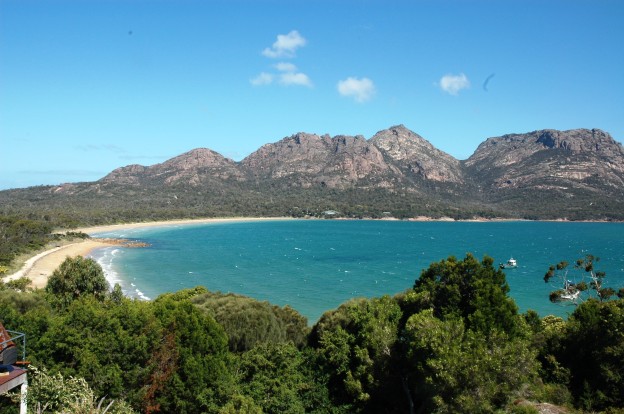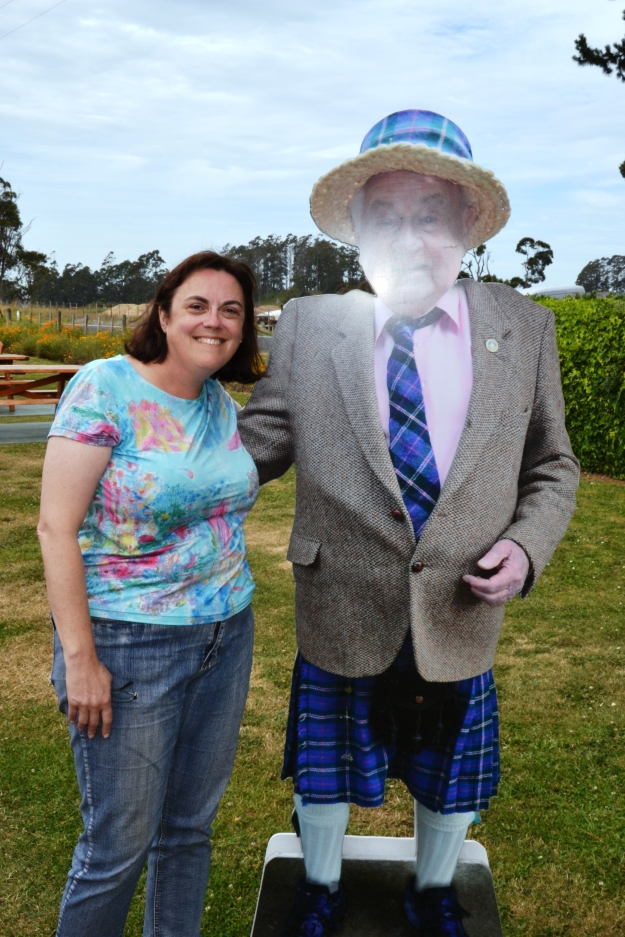Welcome to Z – the last day of the A-Z April Challenge.
Throughout the challenge, I’d been planning to visit Zeehan as our last stop. Located on the North-West Coast, Zeehan was an obvious choice and posed a great alternative to the inevitable “Zoo” . Moreover, Geoff’s Great Uncle, Robert Ralph French, was a teacher in Zeehan before being Killed in Action in France during WWI. However, although we have that personal connection with the town, we’ve never been there, which makes writing about it a tad difficult, though not impossible.
Moreover, unless we went to the Tasmanian Devil Unzoo, we haven’t had a chance to meet the infamous Tasmanian Devil or find out about it’s battle to survive. It is now listed as an endangered species and much work is being done to conserve it.
“THERE are three hateful things in the world, two that make the blood run cold, and one that makes it boil; the hiss of a snake, the snarl of a Tasmanian devil, and the smile of a banker.”
– Eimar O’Duffy in “Asses in Clover.”
As we’ve continued through our A-Z Alphabetical Tour of Tasmania, there’s been what we’ve seen, but also what we haven’t seen. For better or worse, the haven’t seens include the Tasmanian Devil. Although my son swears he heard one howling in the night, and even glimpsed it through the bathroom window, so far we haven’t seen or even heard one at all.

So, instead of heading West to Zeehan, we’re now heading South to the Tasmanian Devil Unzoo in Taranna, which is helping to conserve this endangered species.
“UNZOO – a place where the public learns about wild animals, plants and ecosystems through interaction with and immersion in natural habitats.”
– John C Coe and Ray Mendez, 2005, The Unzoo Alternative
Since 1996, Tasmania Devils have been blighted by an infectious cancer known as Tasmanian Devil Facial Tumor Disease (DFTD). Since then, the population has declined by more than 60%.6 Transmission can occur by biting, feeding on the same material, aggressive mating, and other social interactions. DFTD tumors mostly form on the face and/or in the oral cavity. The cancer can also metastasize to other areas of the body. Nearly 100% of infected devils die within 6 months of the onset of clinical signs.7 Death results from an inability to feed, secondary infection, or symptoms associated with metastases. Sadly, as a result, what was once the largest surviving population of marsupial carnivores is now threatened with extinction.
The Tasmanian Devil Unzoo is taking a proactive part in helping to save the Tasmanian Devil:
“Tasmanian Devil Unzoo has a long history of supporting efforts to save the Tasmanian devil, and is a partner in the official Tasmanian Devil Conservation Project. This critical project aims to save Tasmanian devils on the Tasman Peninsula by preventing the spread of the DFTD to the region.
As part of this effort, Tasmanian Devil Unzoo is breeding healthy devils for future wild release on the Peninsula. We also maintain a special devil-proof barrier fence at Dunalley, which has been designed to prevent the spread of DFTD into the disease-free Tasman Peninsula region. In addition, through our Devil Tracker Adventure project, we constantly monitor our local wild devils and collect important information on the local devil population through infra-red cameras and data recording.[1]”
Unfortunately, as I’ve mentioned time and time again, we ran out of time in Tasmania and we didn’t make it to the Tasmanian Unzoo when we were down there in January. However, we live right near the Australian Reptile Park on the NSW Central Coast. So, we can see Tasmanian Devils and other Australian wildlife there. You probably don’t have this luxury.
Before I turn you over to the Unzoo, I thought I’d better introduce you to the Tasmanian Devil first.
That said, I’m anything but a Tasmanian devil expert and I’m largely going on reputation. Obviously, I’ve never snuggled up to a Tassie Devil to get to know them personally, let alone had the opportunity to run through the Proust Character questionnaire with one.

However, as you may recall, I do have my in-house Tasmanian (my husband Geoff). Geoff has told of the Devil’s incredible ability to polish off an entire cow carcass in two weeks including the skin. Out on his cousin’s farm, they’d dump a dead cow out in the bush and two weeks later, the big knee bone was all that remained. It takes a powerful set of jaws, and a cast iron stomach to pull that off, making the Tassie Devil an animal to be feared, but also given a kind of respect.

In search for more stories, I read through some of the old newspapers online and found out about some devils who were sent to the London Zoo. These accounts provide some good insights into public perceptions in the past:
According to the “Overseas Mail” of 2nd December, the authorities at the London Zoo…are extending a warm welcome to live Tasmanian devils. These animals belong to the marsupial group of animals, and may be described as the black sheep of the respected kangaroo family. In appearance the devil; is quite as black as its namesake is painted, and is about the size of a badger. The broad, strong head is armed with tremendous jaws and teeth, and its sole touch of colour is a suggestion of pink about, the muzzle and ears, and a white V-shaped marking on the chest. It is absolutely untamable, kindness seems as much wasted on it, as on a bursting shrapnel shell. Its ferocity is only amenable to buckshot or strychnine. It will fight a man, a sheep, a dog or its own relations. Kill it and it dies snarling defiance. Give it food, and it bites the hand that feeds it with every sign of satisfaction. The mother produces three or four little devils at a time… Telegraph (Brisbane, Qld. : 1872 – 1947), Thursday 4 January 1912, page 3
…..
A LONDON IMPRESSION: The Tasmanian Devil
Four Tasmanian Devils, fiends in animal shape whose life is one unceasing anger against everybody and everything, have arrived at the London Zoo. No matter what you do for or against a Tasmanian Devil he remains furious. In his native Australia he is the terror of the sheep-farmer. Woe betide any farmer who relaxes watch, for the Devils have an uncanny knack of knowing just when it is safe to appear among the flock and tear out the throats of their helpless prey. It is some years ago since the Zoo entertained a Devil, and anybody with a taste for excitement should visit the newcomers. A new cage, with “unbite-able” steel bars, has been prepared, and the four hideous strangers are now boiling with fury in it from morning to night. The Tasmanian Devil is jet-black, with massive jaws which will tear ordinary wire mesh into shreds in a twinkling. In his wild state he fights his fellow Devils on the slightest provocation and the victor often devours the vanquished. Daily News (Perth, WA : 1882 – 1950), Saturday 26 December 1931, page 12
Yet, despite such horrific reports, I also found a report of three Tasmanian Devils being sent to Hollywood to appear on screen:
ASPIRANTS FOR FILM FAME: Tasmanian Devils For Hollywood
Zoologically, the Tasmanian Devil-latest candidate for Hollywood film honors— is an “Interesting little animal.” Destined for a film career, three of them, on Friday next, will leave Hobart on the first stage of a 7000 miles trip to Hollywood. They have been selected as supporting artists for Rosemary Lane in a coming talking picture. On the way they will be housed for a few weeks at Taronga Park. Latent talent, no doubt, has caught the eagle eye of Hollywood’s talent scouts. If so, it is a case of history repeating itself, for, like the prophet, the Tasmanian Devil has found little honour in its own country. The secretary of the Taronga Park Trust (Mr. Brown) said to-day that there were no Tasmanian Devils in the Sydney Zoo. “They are not zoological rarities by any means,” he said, “but for display purposes we have found that the public generally is not very interested in them,” Sun (Sydney, NSW : 1910 – 1954), Thursday 11 May 1939, page 9

Taz.
So, while the Tassie Devil might not make the ideal dinner party guest, it is an essential part of biodiversity in Tasmania and needs to be saved.
At this point, I’m going to take you over to the Tasmanian Devil Unzoo’s website where you can go on a self-guided tour.
I hope you enjoy it, but also gain a heightened sense of the need for the conservation of all species of animals and plants to ensure biological diversity in the future. It is much better to look after what we’ve got, than try to bring it back from the dead down the track (the Tasmanian Tiger being the case in point).
Once you’re finished there, we’re heading back to Devonport to catch the night ferry to Melbourne, leaving Tasmania behind.
By the way, don’t forget to stock up on goodies before you leave. I know we are…including a dozen Cornish pasties from Scottsdale, Lavender Cheese from Ashgrove Farm, chocolate from the House D’Anvers and Hard Ginger Beer from Spreyton’s Cider.
Indeed, I’d stuff all of Tassie in my suitcase if I could!
Carpe diem…seize our last day!
xx Rowena
The Details for The Tasmanian Devil Unzoo
5990 Arthur Highway. Taranna Tasmania 7180 Australia
T: Within Australia 1800 641 641
T: International +61 1800 641 641
W: http://www.tasmaniandevilunzoo.com.au
References
[1] https://tasmaniandevilunzoo.com.au/save-the-devil/
Featured image -The Tasmanian Devil Unzoo








































































 Me being me and having the opportunity to meet Tazmazia’s creator, I had to ask him the inevitable: “Why did you built it?” He explained how he liked building things and using his hands and one thing lead to another. He also told us about how he had this guy come through who said he really envied what he’d done. How he’d been able to create his own town from scratch. He asked him what he did for a crust and the man replied: “Town Planner”. Ah! I could just imagine his frustration!
Me being me and having the opportunity to meet Tazmazia’s creator, I had to ask him the inevitable: “Why did you built it?” He explained how he liked building things and using his hands and one thing lead to another. He also told us about how he had this guy come through who said he really envied what he’d done. How he’d been able to create his own town from scratch. He asked him what he did for a crust and the man replied: “Town Planner”. Ah! I could just imagine his frustration!